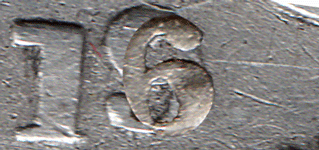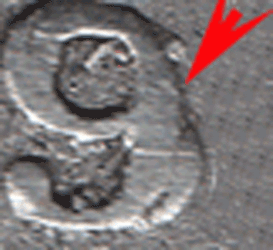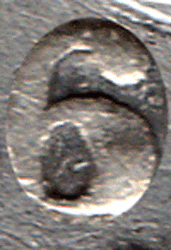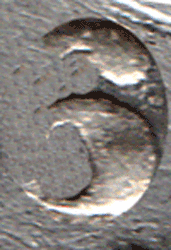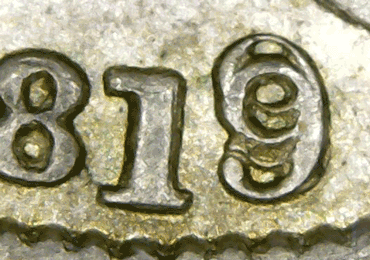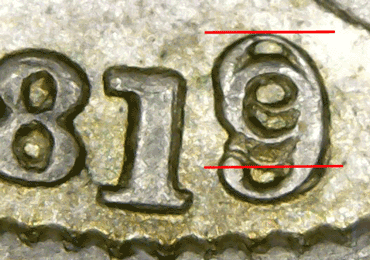|
Michael Coins Ltd |
![]() Other Lists
Other Lists
COIN CLUB
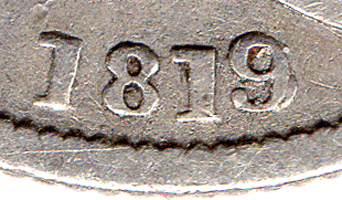 |
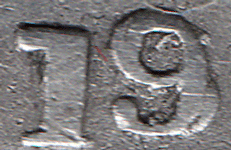 |
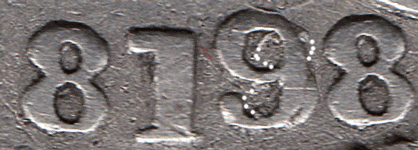 |
|
|
Fig. 1
1819 shilling The 9 is over ? |
Fig. 2
A slightly larger scan of just the '19' |
Fig. 3
On this scan I have copied the 8 (to the right of the 9) to see if it would fit. If one looks at the extra 'bit' at the lower right outside of the 9 one can see clearly that it is a different shape to the lower right side of an 8 ! It is smaller & more rounded. |
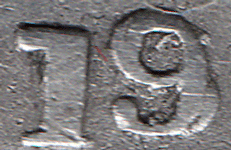 |
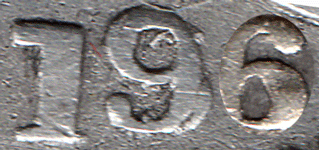 |
|
|
Fig. 4
A slightly larger scan of just the '19' |
Fig. 5
I next looked at the possibility that it might be an INVERTED '9' but the 9 of that date is larger and the under numeral is smaller. I took a 6 from an 1816 shilling which is smaller and copied it (to the right of the 9). it appears to be a very good fit. The rotation might be slightly different to mine. The shape and size are good - even the 'bit' sticking out of outside of the 9 could be that of a 6 |
Fig. 6
I next changed the rotation of the 6 and superimposed it on the 9. This is the result. On the test punch - ONLY the right hand side of the punch was angled down and left its mark.
|
My Conclusion: (12 August 2015)
Date: The original 9 (of the date) is larger than the "under" numeral. See Fig. 2
The 8 is smaller than the 1's or the 9. See Fig. 3
The 9 was originally thought to be over the smaller style 8. See Fig. 3
It is possible that the 9 could be over an INVERTED 9 (which would look like a 6 !)
However, It cannot be the 9 punch that was originally used for that coin as it is larger that the under-strike coin.
In 1816 shillings a smaller 6 punch was used (to the 9 numeral). See Fig. 4
It is possible that this smaller punch was used as the base of the 9 is in exact alignment with the under numeral
bur does not reach as high or as tall as the top of the 9. See Fig. 5 & 6
It is possible that the 6 punch was picked up by accident (if it happened to be laying upside down !) looking like
a 9 punch ! But accidentally this 6 punch was used in right way up (as a 6) !
|
|
|||
|
Fig. 7
Another reason for it NOT being a 9 over 9 is at the angle that the under numeral was struck the back of the 9, at the top, would also be struck and in this case there is the 'gap' as would be natural if a numeral 6 was used. |
So in my considered opinion the only logical explanation of
the under numeral for this Royal Mint repair is 9 over 6.
A new thought offered by a collector: (13 August 2015)
Just a day after posting my above observations, that I thought that the 9 was over a 6, I was advised by a
collector that he had purchased over the years a couple of very similar 1819 shilling - (as shown above).
The coins the collector purchased are in a far better grade than my example. See Fig. 8 & 9
The collector is fairly convinced that the under-numeral is a 3 rather than a 6.
He suggested that the Mint had a range of numeral punches in various sizes and styles at their disposal
and for some reason a 3 was used for a repair in this case.
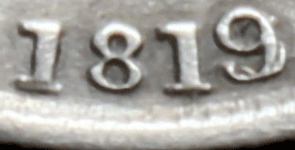 |
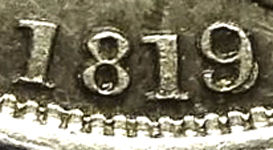 |
|
Fig. 8 As purchased from Ebay considered to be 9 over 3 |
Fig. 9 Also purchased from Ebay listed as 9 over 3 |
 |
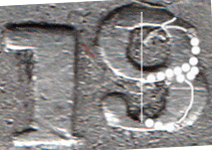 |
|
Fig. 10 A slightly larger scan of just the '19' |
Fig. 11 Could there be a small 3 under the 9 !? |
|
Now these (above) coins look the same or similar to the repair of the 9 to my above scans. See Fig. 8 & 9 & 1 I have put some white dots to represent the 'possible' 3 underneath and a white vertical line to show that the 3 points of the 3 could line up (top, middle & bottom). See Fig. 11 This is a valid suggestion and has merit except that it would appear to be illogical. Why and if it is not a 3 - what numeral ? |
|
|
|
|
|
||
|
Fig. 12
My 6 taken from Fig. 5 |
Fig. 13 The 6 of Fig. 12 with part of the left side erased |
Fig. 7
The gap as seen on Fig. 8 9, 10, 12 & 13 |
|
My comments are:- (1) It cannot be the using up of an 'old' 1813 die - as it never existed ! (2) The 'new' coinage ONLY started in 1816. So would a 3 numeral punch have been made (or even be available) ? (3) Is it possible that a carefully positioned 3 punch, of the right size and style, could strengthen the back of the 9 that needed repairing ? Was it the back of the 9 that needed repairing or the whole of the 9 ? (4) Why or who would an engraver use a 3 punch on a repair to a 9 ? Especially when a 9 punch is readily available. It is illogical ! |
Now why do people consider that the under numeral is a 3 ?
Firstly because it looks like a 3 !
The next question is there another way that the numeral punched could resemble a 3 and not be a 3 ?
The answer is - yes !, very easily. When a repair was made a 'test' or 'trial' punch the person doing the
repair would want to make sure that the punch was correct as both numeral and alignment. The repairer
would always only punch lightly, at an angle, to see if they were correct aligned, etc. Therefore only part
of that numeral or digit would show – from this 'trial' punch they could see if the alignment / numeral, etc.
was correct or NOT !
I have taken my original "6" that I use for this article and have removed some of the "left" side to indicate
what it would look like to the person making the repair if he struck down only using the right side of the
punch. See the two pictures above. Fig. 12 & 13
That to me is what looks like is below the 9. It is NOT a 3 ! Once again there is a "gap" missing on all of
these examples, towards the top, of the underlying numeral which is were the "gap" a 6 would make.
If it were a 3 it would have a full "solid" in this area. Fig. 7
~~~~~~~~~~~~~~~~~~~~~~~~~~~~~~~~~~~~
Brought to my attention: (13 August 2018) Scan by www.drakesterling.com
|
|
|
|
|
Fig. 14 1819 Shilling 9 over 9 - slightly mis-struck higher and slightly to the left. It is possible that 3rd "correcting" strike was made as there is a slight bit of "extra" lower back (right side) to the 9. |
Fig. 15 1819 Shilling 9 over 9. Red lines added to show that the size of the underlying 9 is of the same size as the original 9. |
This scan of this1819 Shilling was sent to me asking for my advice at to the attribution now
given to this coin was correct ?
The person asking wrote "it was described by a reputable auction house at the time it was
acquired as an '1819 over an "uncertain" numeral, possibly a 9, or an 8'......
and subsequently attributed as an 1819 over 6 by a third-party."
Having examined the scan and measured the size of underlying numeral I could only conclude
that the underlying numeral was a 9. The size of the underlying 9 is exactly the same size as
the original 9 and therefore logically should be a 9. If it had been an "inverted" 6 or "upright" 6
the numeral would have been smaller as per my conclusion for Fig. 5 & 6.
Therefore: 9 over 9 - a poorly struck repair of the 9 (high and slightly to the left).
~~~~~~~~~~~~~~~~~~~~~~~~~~~~~~~~~~~~
Also brought to my attention: (13 August 2018)
Spink in their auction 25 March 2015, Lot 783. Picture an 1819 Shilling.
https://www.the-saleroom.com/en-gb/auction-catalogues/spink/catalogue-id-srspi10039/lot-f93fcf8d-6242-4523-b48e-a4530106282c
George III (1760-1820), Shilling, 1819 over 3, laureate head right, rev. shield (ESC.-; S.3790), practically mint state,
the overdate not listed in ESC, with a letter from Kevin Clancy, Director of the Royal Mint Museum, dated
1 November 2012, which states 'Close examination of the date and comparison with similar coins in the Royal Mint
Museum have led to the conclusion that a 9 has been entered over a 3
The coin pictured is similar if not identical in date / overdate to that which is shown on my Fig. 1 & 8.
I find that I am at odds with the Royal Mint conclusion as I do not believe that there is such an overdate
as 1819 with 9 over 3 for the above reasoning of this article.
I would naturally accept their finds if they had X-Rayed the coin and had seen that it was a natural 3
BELOW the 9. However, with the gap at the top left (as per Fig. 7) I do not see how that is possible !
From the comment "Close examination of the date and comparison with similar coins in the Royal Mint Museum"
Does this mean that the Royal Mint in their Museum have an 1813 Shilling ?
The Royal Mint did not really make any silver coins for circulation dated after 1787; only gold coins.
They did however counterstamp foreign captured coins with an oval or octagonal silver 'hallmark'.
The Bank of England issued a silver 'Dollar' (Crown) in 1804 and from 1811 to 1816 produced silver
Three Shilling and Eighteenpence (One Shilling & 6 Pence) as an 'Emergency' issue for this period.
The Royal Mint only started producing silver coins in 1816.
I would accept the Royal Mint conclusion if they could prove my conclusion incorrect !
Afterword: Understanding of the Royal Mint practices, at that time, are that single punches were
made "uniquely" to that die and they would not have made unnecessary numerals or letter punches
that were not needed or required.
I believe that the Royal Mint make what dies and punches they need for that year. Why make all the
numerals punches 0 to 9 or letter punches A to Z when you are not going to use them all: that would
be considered a waste of money ! The Royal Mint used good 'husbandry' (good, careful management !)
The reason for making only what was needed was possibly because in the following year the Royal Mint
might need to change either the obverse or reverse dies or both as was the case with the death of
George III in January 1820. The George IV shillings saw the date change place from below the bust on
the obverse to the reverse in 1821 and then the (date) numeral size became even smaller in 1823.
I would have thought that In, the first year, 1816 when the new shillings were made the Royal Mint
engravers would have only needed to have made the 1, 6 & 8 numeral punches; in 1817 they would
have added a 7 punch and in 8 they could 'possibly' have used the already available 8 !?
So in 1819 they would have a 1, 6, 7, 8 punches available with only the need to make only a 9 punch.
There would be no need for a 0, 2, 3, 4 or 5 punch to have been made or be mistakenly picked up !!
| Back to shillings |
